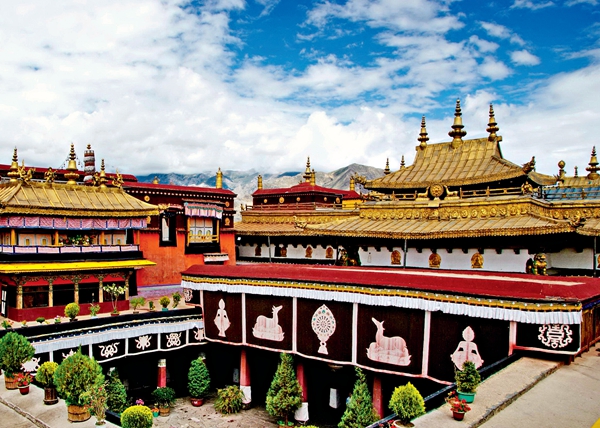Tips in Lhasa
 0 Comment(s)
0 Comment(s) Print
Print E-mail China Today, October 13, 2017
E-mail China Today, October 13, 2017
Chakpori:

Located southwest of the Potala Palace, Chakpori is one of Tibet's holy mountains. The temple on its summit is regarded as the birthplace of Tibetan medicine. To its east are well-preserved stone grottoes built more than 1,000 years ago, which house statues of Songtsen Gampo and Princess Wencheng, and six-character mantras and inscriptions have been carved in various calligraphic styles on the mountainside. Chakpori is the best vantage point for shots of the Potala Palace, especially at dawn when it is illuminated by the sun's first rays.
Jokhang Temple:

The grandest work of architecture from the Tubo Kingdom is also Tibet's earliest wood-and-earth construction. Located at the center of Lhasa's old town, it is the foremost Tibetan Buddhist monastery, and the reason why Lhasa is known as "Sacred City." Jokhang Temple reached its present scale after centuries of expansion.
Combining the architectural styles of Tibet, Tang Dynasty China, Nepal, and India, it has become an ancient archetype of Tibetan religious architecture. The temple houses statues of Songtsen Gampo and his two wives Princess Wencheng and Princess Bhrukuti, and also the murals titled "Princess Wencheng Enters Tibet" and "Jokhang Temple under Construction." Constantly heaving with devout believers, in 2000 the Jokhang Temple and the Potala Palace were listed as world cultural heritage.
Do and Don'ts
1. As Lhasa is located on a plateau, visitors might temporarily experience altitude sickness, so be prepared for this. People with heart disease, high blood pressure, respiratory problems, epilepsy, or bad colds are advised not to travel in Tibet.
2. Non-Chinese citizens to Tibet must obtain travel permits to Tibet issued by the Tibet Autonomous Region Tourism Bureau.
3. Respect local religious customs. Do not spin prayer wheels in the wrong direction. Do not touch people's heads. Do not smoke, touch statues of the Buddha, open sacred books, ring bells, sit on the seat designated for the Living Buddha, raise your voice, or take photos in temples.
4. When encountering a monastery, Mani stone site, pagoda, or other religious entities, be sure to pass it from left to right. Do not step over ritual items or braziers.






Go to Forum >>0 Comment(s)